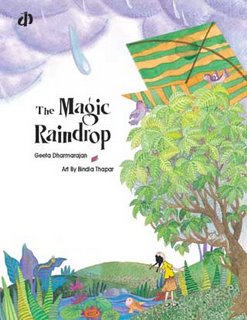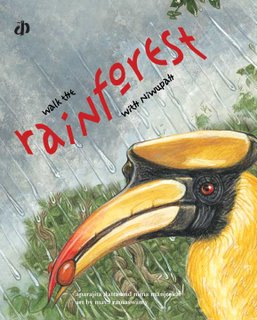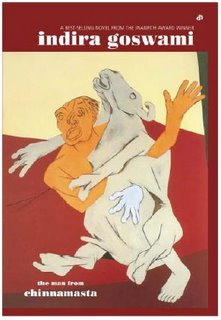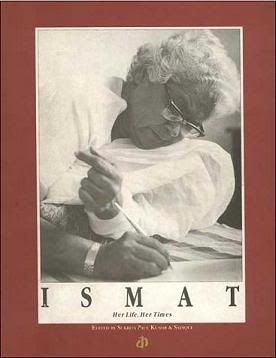Senior Assistant Editor Pankaj Upadhyay, rediff.com
The author
The translator
Publishers: Katha
Cover Painting: Chittrovana Mazumdar
Price: Rs 200
ISBN: 81-87649-74-7
KATHA is a non-profit, "profit-for-all" organization. We're leading publishers of translations, bringing the best of Indian Fiction into English. In this blog, you'll find media mentions of Katha and Katha's works. And a little about our adventures in publishing.
Senior Assistant Editor Pankaj Upadhyay, rediff.com
The author
The translator
Publishers: Katha
Cover Painting: Chittrovana Mazumdar
Price: Rs 200
ISBN: 81-87649-74-7


"The master magician, Mayil Ravana, hascast a stupendous spell! He’s kidnappedRama and Lakshmana. Now, no one canever find their way to the Lotus Kingdomto rescue the princes.But, wait! There goes Hanuman, the sonof the swishing wind and a trusted friendof the princes, gliding across the bluestsky in search of the nether world. Hedares through crashing waves, fire-sparksand mirror-demons to blow out theslithering flames under the sea. Slip into your invisible diving suits for a splashing,big adventure!"
The New Indian Express
(School Magazine, September 13, 2006)
The book is about Hanuman and his various adventures while rescuing Rama and Lakshmana from the clutches of evil magician, Mayil Ravana. This is a 600-year old story, an offshoot of the epic Ramayana, retold by Madhavi S Mahadevan.
When Ravana sees that he's going to lose the war against Rama and his vanara army, he summons his younger brother, Mayil Ravana, king of Pataala Lanka, and asks for his help. Ravana orders Mayil, who is a master magician, to get rid of Rama and Lakshmana. When the news of the evil magician's plan reaches Rama's camp, Hanuman (the son of Vayu, Lord of the Winds), is given the task of protecting the princes.
Hanuman builds a fortress with his tail. This fortress can only be entered through Hanuman's mouth. The evil magician disguises himself as Dasharatha (Rama's father) and Bharata (Rama's brother). When his plans fail, he disguises himself as Vibhishana and Hanuman allows him to enter. Hanuman realises his mistakes when the real Vibhishana returns, but by then, it is too late. The princes are kidnapped.
To correct his mistake, Hanuman goes into the nether world to rescue Rama and Lakshmana, braving crashing waves, firesparks and mirror demons.
Hanuman encounters many hurdles in his journey. During the course of his journey, Hanuman meets his son Macchavallavan. Being a true warrior, Macchavallavan does not let him inside Pataala Lanka. So, Hanuman has to render him unconscious. He encounters millions of rakshasas but he kills them all.
Inside the fortress, he meets Turatanti, Mayil Ravana's siter, who helps him kill the evil magician.
The writings are simple and interesting enough to hold the interest of readers. Illustrations by Srivi are beautiful and modernistic. The drawings of Hanuman resemble that of a child, probably in order to hold the interest of young readers. The expressive illustrations are the plus point of the book.
- Dilip Kumar Shaw
The author
Madhavai S Mahadevan
The illustrator
Publishers: Katha
Also available in Hindi.
40 pages, size 11 x 8.5
Age group: 5-9 years
ISBN 81-89020-30-7 [HB]
81-89020-29-3 [PB]
81-89020-36-3 [Hindi]
Price: Rs 175 [HB]
Rs 100 [PB]
Rs 95 [Hindi]
Hindi: Rs 150 [HB]
Rs 95 [PB]

Publishers: Katha
88 pages, size 11 x 8.5
Age Group: 7-12 years
ISBN 81-89020-33-1
Price: Rs 295
Katha thanks the North East Writers' Forum for their cooperation.

The Hindu
(Young World, October 14, 2005)
This is a book that's a bit like a tour guide trying to show you all of Jaipur's sights in an afternoon. It's all crammed in and rather hurried but terribly interesting and beautiful to look at.
The book Walk the Rainforest with Niwupah does exactly what the title says — it takes the reader on a quick trip through the rainforest, pointing out the sights and sounds along the way.
Authors Aparajita Datta and Nima Manjrekar, both wildlife specialists, have simplified the complex ecosystem of the rainforest making it easy to understand and fun to read. Aparajita has spent years in the rainforests of the Northeast, studying and helping to conserve its rich wildlife and she has tried to bring these experiences to the book.
Tour guide
A Great Indian Hornbill named Niwupah acts as the tour guide, squawking out facts about dung beetles, Hoolock gibbons, flying squirrels, barbets, woodpeckers and other creatures of the forest.
Maya Ramaswamy's artwork — colourfully detailed pictures of animals, insects and plants — really lifts the book from just one full of information to a real walk through a glorious place full of life and energy.
This 32-page tour ends with a quick message on the threats facing the forest and the need for conservation. Though it doesn't really give one an idea of the urgency of the issues facing the survival of the forests, Walk the Rainforest is a good introduction to the world of wildlife.
- Shalini Umachandran
The authors
Aparajita Datta
Nima Manjrekar
The Illustrator
Maya Ramaswamy
Publishers: Katha
36 pages, size 10 x 8
Age Group: 7 - 12 years
ISBN 81-89020-15-3 [HB]
ISBN 81-89020-16-1 [PB]
Price:Rs 150 [HB]
Rs 95 [PB]

"From the window of my room I see amazing things ..."

Leaves zooms into the colour and magic of nature. A delightful book from the Colombian illustrators Enrique Lara Robayo and Luis Fernando Garcia Guayara, winners of the Encouragement Prize in the 12th Noma Concours for Picture Book Illustrations.
A book that can be read and enjoyed by everyone, from the very young to the very old!
Publishers: Katha
Available in both Hardback and Paperback Editions.
Text and Illustrations: Enrique Lara and Luis Garcia.
Age Group: 5 years +
ISBN 81-89020-07-02 [PB]
ISBN 81-87649-88-7 [HB]
Price: Rs 100. (India and the subcontinent)
Ismat: Her Life, Her Times

India Today
(April 3, 2000)
Synopsis
Writer of short stories and novels, essayist and playwright – Ismat Chughtai is one of the best and most colourful personalities in modern Urdu literature. A rebel with a fiercely individualistic way of thinking, replacing idealism in fiction with reality, her writings are not mere figments of imagination, but reflections of what she had herself experienced and perceived.
Ismat oberved with a burning curiosity the way of life around her, especially the young women who led a suffocting existence confined within their homes, observing strict purdah. She writes about how supression led to complexes in gender identity and made one stray into illicit relationships, even homosexuality.
This volume attempts to present different aspects of this vibrant, forceful, multi-faceted personality – what she thought of herself and what her critics and contemporary authors thought of her. Accompanied by her letters, extracts from her autobiography and other works, warm and informative, articles by well-known writers like Manto, Qurratulain Hyder,Faiz and Krishen Chander amongst others, snippets from her interviews, a comprehensive chronology a detailed family tree tracing the writer’s antecedents back to Chengez Khan, and a potpourri of interesting mementos from her life, this book promises to be an absorbing and compulsive read for scholars and laymen alike.
Reviews and Commentary
This is a fun and imaginative book. As a concept it’s wonderful-literary criticism, biography and autobiography, with lots of photos, box items and memorabilia – a real guide book to Ismat Chughtai, one of Urdu’s great modern writers and script/story writer of a bevy of Hindi films, particularly the moving Balraj Sahani starrer about Partition, Garam Hawa.
To recreate her times Katha’s editors have brought together all her “set” at a period when being a writer was truly exciting, when it mattered, when, and many of them were, of course, communists, and thought they could change society. The contributors read like a who’s who of mdoern Urdu writing- there’s Faiz Ahmad Faiz, Sadat Hasan Manto, Krishan Chander and Qurratulain Hyder Commenting on Ismat.
- Gillian Wright
The Telegraph
(December 12, 1999)
And for the first time in English a book – Ismat: Her life, her times – puts a writer’s career and preoccupation in perspective. Laced with anecdotes, it is primarily a collection of essays by the writer herself and by fellow authors and critics. The book helps us see Chugtai’s life and work in its context and tradition; the life she led and the culture she hailed from.
- Avijit Ghosh
The Hindu
(May 21,2000)
Ismat: Her Life, Her Times is a tribute to Ismat Apa. First in a series of Katha’s Approaches. To Literature in Translation, it attempts to put a writer’s entire body of work in its correct socio-cultural, political and historical perspective. Edited by Sukrita Paul Kumar and Sadique, this volume contains extracts from Ismat’s ouvre, family photogrphs and memorabilia.
- Rakhshanda Jalal
The Express Magazine
(April 9, 2000)
Sadly, in this haze of cultural laments another trend is overlooked. The last decade has witnessed a phenomenal growth in the translation industry, making works of repute available to an over swelling readership. Probing a lazy obsession with celebrityhood is beyond the scope of this review, but books like Ismat offer a welcome counterpoint to literary pessimism.
The first of a series planned in Katha’s Approaches to Literature in Translation series, aimed at putting India’s non-English literary heritage in perspective.
- Mini Kapoor
The Hindustan Times
(June 4, 2000)
The overall impression of the books is positive and encouraging. Urdu died because it could not provide a living for even its master writers like Ghalib, Majaaz and `Firaq.’
Perhaps the retelling of Ismat in English will help keep her – and thus something in Urdu – alive in some small and obsecure way, Here’s hoping.
- Akhilesh Mittal
Edited by Sukrita Paul Kumar & Sadique
Price: Rs 395
Binding Type: Paper Back
Series: KATHA ALT SERIES: APPROACHES TO LITERATURE IN TRANSLATION